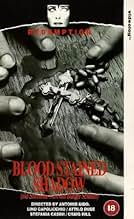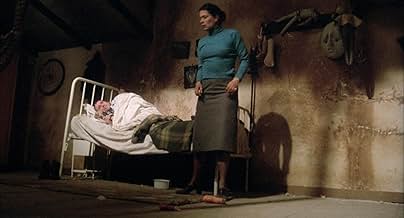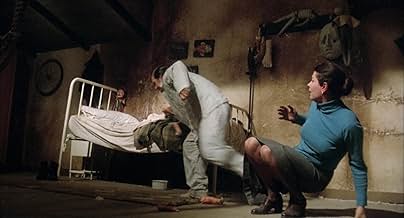IMDb-BEWERTUNG
6,3/10
2161
IHRE BEWERTUNG
Füge eine Handlung in deiner Sprache hinzuThe body of a schoolgirl is found in a meadow. The murderer is never caught, and years later, a young man named Stefano returns to the island and is reunited with his brother, the local prie... Alles lesenThe body of a schoolgirl is found in a meadow. The murderer is never caught, and years later, a young man named Stefano returns to the island and is reunited with his brother, the local priest.The body of a schoolgirl is found in a meadow. The murderer is never caught, and years later, a young man named Stefano returns to the island and is reunited with his brother, the local priest.
Craig Hill
- Don Paolo
- (as Graig Hill)
Alina De Simone
- Medium
- (as Alina Simoni)
Sonia Viviani
- Girl walking with Signora Nardi
- (as Sonia Vivani)
Fortunato Arena
- Antonio, Innkeeper
- (Nicht genannt)
Antonio Bido
- Man at cemetary
- (Nicht genannt)
Eolo Capritti
- Customer in restaurant
- (Nicht genannt)
Empfohlene Bewertungen
Directed by Antonio Bido, this is by far his best film of his career (Though, admittedly, his only other film of any note is the 1977 Giallo "Watch Me When I Kill").
The film's narrative is relatively typical of a giallo: Someone is killing people in a small village and a priest tries to unravel the mystery of the killer's identity. What's atypical is the film's tone. The film is noteworthy for being one of the more serious and mature of the giallo genre. Bido avoids the giallo's often sleazy nature and embraces the Gothic and religious aspects instead.
Another interesting point is how the film focuses on two main protagonists, the priest and his brother, and how they collaborate with one another to discover the killer. Interesting narrative method having two focal points rather than one, not original but unconventional.
The performances are generally good with Craig Hill as giving an impressive performance as the priest. He exhibits a broad range of emotions from anger to sorrow, from determination to helplessness, and makes it totally convincing.
The cinematography is main feature of the film because it is its strongest trait. The visuals portray a wet and muggy Italy, with fog and mist enveloping the landscapes and rain falling, creating pools of water. This all builds a gloomy and foreboding atmosphere that conveys feelings of isolation, loneliness, dread, anguish, and death.
The characters are generally good as well, each with a strong history and believable relationships between one another. The greatest of which is the relationship between the priest and his brother, which is totally believable because not only of both of their performances, but also the development of their characters.
And lastly, the film features some wonderful aesthetic qualities through it's use of editing. Bido inter splices Catholic and Religious imagery to make comments about the characters and the religious institution as a whole.
The film has a few problematic issues. First of all, the narrative isn't clearly focused. The film appears to be more concerned with the visuals and the individual, isolated events in the film rather than the mystery as a whole. Thus, this damages the film's impact as it approaches the end, because here the mystery plays center stage but is underdeveloped.
The narrative also suffers from several of the genre's conventions and clichés, thus leading to a sort of predictability of the story. The film features the typical gloved killer, the extended stalking sequences leading to a gruesome death, the multiple red herrings, childhood traumas, and a host of other archetypes of the giallo.
Also, the final revelation stretches plausibility and thus may become unacceptable to some viewers, especially when one recalls the events that have transpired throughout the film.
Never the less, this is one of the better giallos out there.
Recommended to those who enjoy the mystery/thriller genre, though it is not essential unless you are a fan of the giallo genre. For the casual film viewer, there are better examples of the giallo genre and thus would recommend that you skip this and view one of the apexes of the genre such as Suspiria.
The film's narrative is relatively typical of a giallo: Someone is killing people in a small village and a priest tries to unravel the mystery of the killer's identity. What's atypical is the film's tone. The film is noteworthy for being one of the more serious and mature of the giallo genre. Bido avoids the giallo's often sleazy nature and embraces the Gothic and religious aspects instead.
Another interesting point is how the film focuses on two main protagonists, the priest and his brother, and how they collaborate with one another to discover the killer. Interesting narrative method having two focal points rather than one, not original but unconventional.
The performances are generally good with Craig Hill as giving an impressive performance as the priest. He exhibits a broad range of emotions from anger to sorrow, from determination to helplessness, and makes it totally convincing.
The cinematography is main feature of the film because it is its strongest trait. The visuals portray a wet and muggy Italy, with fog and mist enveloping the landscapes and rain falling, creating pools of water. This all builds a gloomy and foreboding atmosphere that conveys feelings of isolation, loneliness, dread, anguish, and death.
The characters are generally good as well, each with a strong history and believable relationships between one another. The greatest of which is the relationship between the priest and his brother, which is totally believable because not only of both of their performances, but also the development of their characters.
And lastly, the film features some wonderful aesthetic qualities through it's use of editing. Bido inter splices Catholic and Religious imagery to make comments about the characters and the religious institution as a whole.
The film has a few problematic issues. First of all, the narrative isn't clearly focused. The film appears to be more concerned with the visuals and the individual, isolated events in the film rather than the mystery as a whole. Thus, this damages the film's impact as it approaches the end, because here the mystery plays center stage but is underdeveloped.
The narrative also suffers from several of the genre's conventions and clichés, thus leading to a sort of predictability of the story. The film features the typical gloved killer, the extended stalking sequences leading to a gruesome death, the multiple red herrings, childhood traumas, and a host of other archetypes of the giallo.
Also, the final revelation stretches plausibility and thus may become unacceptable to some viewers, especially when one recalls the events that have transpired throughout the film.
Never the less, this is one of the better giallos out there.
Recommended to those who enjoy the mystery/thriller genre, though it is not essential unless you are a fan of the giallo genre. For the casual film viewer, there are better examples of the giallo genre and thus would recommend that you skip this and view one of the apexes of the genre such as Suspiria.
The Bloodstained Shadow doesn't do anything you haven't seen a million times over and the killer is so obvious from the start that you spend most of the overstuffed run time wondering why no one is calling out this person. It doesn't have the style, excess, or general unease of an Argento giallo and, instead, feels uncomfortably sandwiched somewhere in between a movie of the week and a less spirited episode of Murder, She Wrote: Jessica Goes To Italy.
There are a few attempts at the sleaze a lot of giallos are known for, but it's a mostly polite, too-classy affair with only the occasional instance of camp when a priest and child molesting piano teacher have a battle over who is more corrupt.
The characters are poorly drawn and uninteresting to follow and the film just doesn't seem to understand this and treats us to long sequences of them going about their day to day lives. Even worse, most of the murder scenes (the highlight of just about any giallo) aren't very creative or interesting.
There are a few attempts at the sleaze a lot of giallos are known for, but it's a mostly polite, too-classy affair with only the occasional instance of camp when a priest and child molesting piano teacher have a battle over who is more corrupt.
The characters are poorly drawn and uninteresting to follow and the film just doesn't seem to understand this and treats us to long sequences of them going about their day to day lives. Even worse, most of the murder scenes (the highlight of just about any giallo) aren't very creative or interesting.
The Blood Stained Shadow is the second – and last - giallo that Antonio Bido directed. His other one was Watch Me When I Kill (a.k.a. The Cat's Victims). While Bido may never be considered one of the masters of the genre, I actually think his two efforts are rather good and at the very least he should be considered one of the best purveyors of the genre in the late 70's. There are some aspects that do stand out in Bido's gialli, making them distinctive. Firstly, there is a somewhat slightly more serious tone and secondly, and most significantly, both films dispense with young sexy women as murder victims. In fact, in both movies it's middle aged characters that end up as the killer's targets. It might not sound like much to some but it is highly unusual, and both of Bido's gialli follow the same pattern. So hats off to the director for being a little bit different. Other than an obligatory sex scene, The Blood Stained Shadow has really no sleaze factor at all.
The story begins with a mysterious slow-motion murder of a young girl. Several years later a maths teacher returns to his home town, where upon a series of murders ensues. Events seem to revolve around a séance group of local bad eggs.
This is another one of those occasional gialli that is set in Venice. The off-season spookiness of the canal streets was also used to good effect in films such as Don't Look Now and Who Saw Her Die? This city does give off a unique ambiance, which is once again utilised well. The film also includes several other odd details in its plot that will be familiar to fans of gialli, such as the weird painting, the retarded boy in the cellar and the present being governed by a terrible event from the past. All of this is put together to construct a film which, while possibly a bit overlong, has a mystery that does actually work in that it isn't too obvious where it's going and there are some decent red herrings sprinkled throughout.
Lino Capolicchio leads the picture. Many of you will be familiar with him from his turn in Pupi Avati's stand-out giallo The House with Laughing Windows. He's an interesting leading man. He's doesn't have the machismo of a Franco Nero, or the shiftiness of a Tomas Milian nor is he as suave as Jean Sorel. He plays characters a little more nerdy, which isn't so common in giallo leading men. He's good and is definitely a good choice for this more serious minded example of the genre. His leading lady is Stefania Cassini, most famous for her turn in Suspiria. I find her really very attractive and a good enough actress. Unfortunately, like here, she is normally dubbed into English by voice actresses. This is a mistake, as anyone who has seen the cult movie Blood for Dracula can confirm she has a beautiful, extremely heavy Italian accent that sounds simply divine. Ah well! The other significant contribution is the music. Stelvio Cipriani is the named composer but seemingly the legendary prog-rock outfit Goblin were key collaborators. It does sound a little Goblinesque at times - though not as good as their usual output to be fair. Still, it's a good soundtrack overall.
The Blood Stained Shadow is definitely recommended to giallo enthusiasts.
The story begins with a mysterious slow-motion murder of a young girl. Several years later a maths teacher returns to his home town, where upon a series of murders ensues. Events seem to revolve around a séance group of local bad eggs.
This is another one of those occasional gialli that is set in Venice. The off-season spookiness of the canal streets was also used to good effect in films such as Don't Look Now and Who Saw Her Die? This city does give off a unique ambiance, which is once again utilised well. The film also includes several other odd details in its plot that will be familiar to fans of gialli, such as the weird painting, the retarded boy in the cellar and the present being governed by a terrible event from the past. All of this is put together to construct a film which, while possibly a bit overlong, has a mystery that does actually work in that it isn't too obvious where it's going and there are some decent red herrings sprinkled throughout.
Lino Capolicchio leads the picture. Many of you will be familiar with him from his turn in Pupi Avati's stand-out giallo The House with Laughing Windows. He's an interesting leading man. He's doesn't have the machismo of a Franco Nero, or the shiftiness of a Tomas Milian nor is he as suave as Jean Sorel. He plays characters a little more nerdy, which isn't so common in giallo leading men. He's good and is definitely a good choice for this more serious minded example of the genre. His leading lady is Stefania Cassini, most famous for her turn in Suspiria. I find her really very attractive and a good enough actress. Unfortunately, like here, she is normally dubbed into English by voice actresses. This is a mistake, as anyone who has seen the cult movie Blood for Dracula can confirm she has a beautiful, extremely heavy Italian accent that sounds simply divine. Ah well! The other significant contribution is the music. Stelvio Cipriani is the named composer but seemingly the legendary prog-rock outfit Goblin were key collaborators. It does sound a little Goblinesque at times - though not as good as their usual output to be fair. Still, it's a good soundtrack overall.
The Blood Stained Shadow is definitely recommended to giallo enthusiasts.
Not unlike the previous years offering from the same director, Watch Me When I Kill, this giallo is somewhat different from the usual genre fare and despite being as complicated as his other and once more with a red herring on every corner and not the bloodiest of kills, this is most enjoyable. The added benefit here is the Venice setting and not the chocolate box, pretty, pretty Venice but the more realistic representation with dark narrow alleyways, cold mist rising from the dark waters and gloomy buildings in various states of decay. There are even more scenes set in the evocative, off the beaten track, Murano. But no delicate glass blowing to be seen, more the back gardens, back alleys and backwaters, all adding to the gloom of this evocative and fascinating picture.
As fans of this particular genre, "giallo", knows there are some characteristics that have to be included: POV-shots from the killer, black gloves and grisly, graphic murders and so on! The gloves are missing here but everything else is! The story is set in Venice where bizarre events are unfolding, leading to death-threats and murders. And everything is connected to an episode many years ago, concerning the strangulation of a young girl. There are echoes from many other giallos, like the classic "Deep Red", but unlike so many other imitators, director Antonio Bido (who made the inferior giallo "The cat's victims") has a true feeling for setting up the set-pieces. His actors are also quite good even if the dubbing, as always, may distract from the viewers pleasure. His knows how to place his camera to enhance the suspense and atmosphere. To complain a little, I too found, like a previous reviewer here, that the episodes between Casini and Capolicchio are a bit squirm-inducing. They are simply put, very boring together, and even a nude scene fails to give any sparks. And the boat trip they take together is a scene that should have been omitted (I do HATE those sunglasses) because it seems to belong in another movie altogether, like some travelogue movie. But otherwise a nice exercise in suspense and horror, even if it is talky in places (most gialli are) and takes some time to get the pace going.
Wusstest du schon
- WissenswertesAt 28'51' when Capolicchio introduces himself to Stefania Casini he tells her he is a Professor of Mathematics, Casini tells him that her job is to deal with furniture and Capolicchio calls her Architect, Stefania Casini actually graduated in Architecture at Polythechnic University of Milan.
- PatzerWhen the killer is being revealed and the main character pulls out the newspaper article, you can see and hear a flash from camera, probably taking pictures of the scene.
- VerbindungenFeatured in Solamente Bido (2002)
Top-Auswahl
Melde dich zum Bewerten an und greife auf die Watchlist für personalisierte Empfehlungen zu.
- How long is The Bloodstained Shadow?Powered by Alexa
Details
- Laufzeit1 Stunde 49 Minuten
- Sound-Mix
- Seitenverhältnis
- 1.85 : 1
Zu dieser Seite beitragen
Bearbeitung vorschlagen oder fehlenden Inhalt hinzufügen

Oberste Lücke
By what name was Blutige Schatten (1978) officially released in India in English?
Antwort























